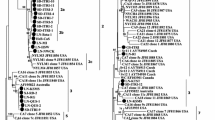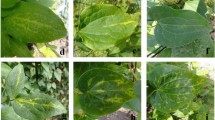Abstract
Over a period of a few years, Pepino mosaic virus (PepMV) has become one of the most important viral diseases in tomato production worldwide. Infection by PepMV can cause a broad range of symptoms on tomato plants, often leading to significant financial losses. At present, five PepMV genotypes (EU, LP, CH2, US1 and US2) have been described, three of which (EU, LP and US2) have been reported in Europe. Thus far, no correlation has been found between different PepMV genotypes and the symptoms expressed in infected plants. In this paper, the genetic diversity of the PepMV population in Belgian greenhouses is studied and related to symptom development in tomato crops. A novel assay based on restriction fragment length polymorphism (RFLP) was developed to discriminate between the different PepMV genotypes. Both RFLP and sequence analysis revealed the occurrence of two genotypes, the EU genotype and the CH2 genotype, within tomato production in Belgium. Whereas no differences were observed in symptom expression between plants infected by one of the two genotypes, co-infection with both genotypes resulted in more severe PepMV symptoms. Furthermore, our study revealed that PepMV recombinants frequently occur in mixed infections under natural conditions. This may possibly result in the generation of viral variants with increased aggressiveness.






Similar content being viewed by others
References
Aguilar, J. M., Hernandez-Gallardo, M. D., Cenis, J. L., Lacasa, A., & Aranda, M. A. (2002). Complete sequence of the Pepino mosaic virus RNA genome. Archives of Virology, 147, 2009–2015.
Cotillon, A. C., Girard, M., & Ducouret, S. (2002). Complete nucleotide sequence of the genomic RNA of a French isolate of Pepino mosaic virus (PepMV). Archives of Virology, 147, 2231–2238.
Eggermont, K., Goderis, I. J., & Broekaert, W. F. (1996). High throughput RNA extraction from plant samples based on homogenisation by reciprocal shaking in the presence of a mixture of sand and glass beads. Plant Molecular Biology Reporter, 14, 273–279.
French, C. J., Bouthillier, M., Bernardy, M., Ferguson, G., Sabourin, M., Johnson, R. C., et al. (2001). First report of Pepino mosaic virus in Canada and the United States. Plant Disease, 85, 1121.
Garcia-Arenal, F., Fraile, A., & Malpica, J. M. (2001). Variability and genetic structure of plant virus populations. Annual Review of Phytopathology, 39, 157–186.
Jones, R. A. C., Koenig, R., & Lesemann, D. E. (1980). Pepino mosaic virus, a new potexvirus from pepino (Solanum muricatum). Annals of Applied Biology, 94, 61–68.
Jorda, C., Lazaro Perez, A., & Martinez Culebras, P. V. (2001). First report of Pepino mosaic virus on natural hosts. Plant Disease, 85, 1292.
Lai, M. M. C. (1992). RNA recombination in animal and plant viruses. Microbiological Reviews, 56, 61–79.
Ling, K. (2007). Molecular characterization of two Pepino mosaic virus variants from imported tomato seed reveals high levels of sequence identity between Chilean and US isolates. Virus Genes, 34, 1–8.
Ling, K. S., & Scott, J. (2007). Sources of resistance to Pepino mosaic virus in tomato accessions. Plant Disease, 91, 749–753.
Lopez, C., Soler, S., & Nuez, F. (2005). Comparison of the complete sequences of three different isolates of Pepino mosaic virus: Size variability of the TGBp3 protein between tomato and L. peruvianum isolates. Archives of Virology, 150, 619–627.
Maroon-Lango, C. J., Guaragna, M. A., Jordan, R. L., Hammond, J., Bandla, M., & Marquardt, S. K. (2005). Two unique US isolates of Pepino mosaic virus from a limited source of pooled tomato tissue are distinct from a third (European-like) US isolate. Archives of Virology, 150, 1187–1201.
Martinez-Culebras, P. V., Lazaro, A., Campos, P. A., & Jorda, C. (2002). A RT-PCR assay combined with RFLP analysis for detection and differentiation of isolates of Pepino mosaic virus (PepMV) from tomato. European Journal of Plant Pathology, 108, 887–892.
Moya, A., Holmes, E. C., & Gonzalez-Candelas, F. (2004). The population genetics and evolutionary epidemiology of RNA viruses. Nature Reviews, 2, 279–288.
Mumford, R. A., & Metcalfe, E. J. (2001). The partial sequencing of the genomic RNA of a UK isolate of Pepino mosaic virus and the comparison of the coat protein sequence with other isolates from Europe and Peru. Archives of Virology, 146, 2455–2460.
Nagy, P. D., & Simon, A. E. (1997). New insights into the mechanisms of RNA recombination. Virology, 235, 1–9.
Olsthoorn, R. C. L., Bruyere, A., Dzianott, A., & Bujarski, J. J. (2002). RNA recombination in Brome mosaic virus: Effects of strand-specific stem–loop inserts. Journal of Virology, 76, 12654–12662.
Pagan, I., Cordoba-Selles, M. C., Martinez-Priego, L., Fraile, A., Malpica, J. M., Jorda, C., et al. (2006). Genetic structure of the population of Pepino mosaic virus infecting tomato crops in Spain. Phytopathology, 96, 274–279.
Page, R. D. (1996). TREEVIEW: An application to display phylogenetic trees on personal computers. Computer Applications of Bioscience, 12, 357–358.
Rast, A. T. B. (1972). MII-16, an artificial symptomless mutant of Tobacco mosaic virus for seedling inoculation of tomato crops. European Journal of Plant Pathology, 78, 110–112.
Roggero, P., Masenga, V., Lenzi, R., Coghe, F., Ena, S., & Winter, S. (2001). First report of Pepino mosaic virus in tomato in Italy. Plant Pathology, 50, 798.
Saitou, N., & Nei, M. (1987). The neighbor-joining method: A new method for reconstructing phylogenetic trees. Molecular Biology and Evolution, 4, 406–425.
Shapka, N., & Nagy, P. D. (2004). The AU-rich RNA recombination hot spot sequence of Brome mosaic virus is functional in Tombusviruses: Implications for the mechanism of RNA recombination. Journal of Virology, 78, 2288–2300.
Soler, S., Cebolla-Cornejo, J., Prohens, J., & Nuez, F. (2000). El Pepino mosaic virus (PepMV), una nueva amenaza para el cultivo del tomate. II. Vida Rural, 119, 48–52.
Soler-Aleixandre, S., Lopez, C., Cebolla-Cornejo, J., & Nuez, F. (2007). Sources of resistance to Pepino mosaic virus (PepMV) in tomato. HortScience, 42, 40–45.
Soler-Aleixandre, S., Lopez, C., Diez, M. J., Perez de Castro, A., & Nuez, F. (2005). Association of Pepino mosaic virus with tomato collapse. Journal of Phytopathology, 153, 464–469.
Spence, N. J., Basham, J., Mumford, R. A., Hayman, G., Edmondson, R., & Jones, D. R. (2006). Effect of Pepino mosaic virus on the yield and quality of glasshouse-grown tomatoes in the UK. Plant Pathology, 55, 595–606.
Thompson, J. D., Gibson, T. J., Plewniak, F., Jeanmougin, F., & Higgins, D. G. (1997). The ClustalX windows interface: Flexible strategies for multiple sequence alignment aided by quality analysis tools. Nucleic Acids Research, 24, 4876–4882.
Van der Vlugt, R. A. A., Stijger, C. C. M. M., & Verhoeven, J. T. J. (2000). First report of Pepino mosaic virus on tomato. Plant Disease, 84, 103.
Verhoeven, J. T. J., van der Vlugt, R., & Roenhorst, J. W. (2003). High similarity between tomato isolates of Pepino mosaic virus suggests a common origin. European Journal of Plant Pathology, 109, 419–425.
Acknowledgements
The authors thank IWT Vlaanderen (IWT 040718), LAVA cvba (Boortmeerbeek, Belgium) and Greenpartners (Sint-Katelijne-Waver, Belgium) for financial support. B.P.H.J.T. is supported by a VENI grant of the Research Council for Earth and Life Sciences (ALW) of the Netherlands Organization for Scientific Research (NWO), and funding from the Centre for BioSystems Genomics (CBSG). Dr. Peter van Baarlen is acknowledged for assistance with phylogenetic analyses.
Author information
Authors and Affiliations
Corresponding author
Rights and permissions
About this article
Cite this article
Hanssen, I.M., Paeleman, A., Wittemans, L. et al. Genetic characterization of Pepino mosaic virus isolates from Belgian greenhouse tomatoes reveals genetic recombination. Eur J Plant Pathol 121, 131–146 (2008). https://doi.org/10.1007/s10658-007-9255-0
Received:
Accepted:
Published:
Issue Date:
DOI: https://doi.org/10.1007/s10658-007-9255-0




